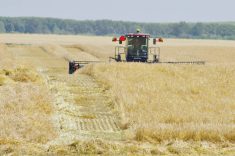Reuters / U.S. livestock producers are trying to cut the amount of wheat they plan to use in their feed rations as prices have rallied to their highest level against corn in 21 months.
But supplies of feed substitutes are scarce, analysts said.
“We do not have a lot of corn out here to compensate for it,” said Jerry Gidel, chief feed grain analyst for Rice Dairy. “I guess we will be feeding quite a few different things. Everyone is going to be scrambling to try to find something.”
Read Also

Manitoba sclerotinia picture mixed for 2025
Variations in weather and crop development in this year’s Manitoba canola fields make blanket sclerotinia outlooks hard to pin down
The spread between the benchmark Chicago Board of Trade wheat and corn contracts surged 122 per cent since the start of the summer even as corn supplies tightened due to the crop-devastating drought that withered crops across the Midwest.
Both corn and wheat prices rallied during the summer, but wheat has held on to its gains better than corn. Wheat prices have dropped 11 per cent from their summer peak while corn is off nearly 16 per cent.
Part of the recent pressure on corn has been better-than-expected yields in the Midwest harvest. But the overall U.S. corn crop, at an estimated 10.725 billion bushels, is still smaller than last year’s 12.358 billion.
The smaller corn supply forced livestock and poultry producers to boost the amount of wheat they fed their animals. Nutritionally, wheat offers more protein than corn but less energy from fat, so most operations have to tinker with rations.
The spread between the two commodities peaked at a $1.61-1/4 premium for wheat earlier this month, its highest since Feb. 14, 2011, before dropping to $1.33-3/4 by Nov. 13.
Feed use and residual for wheat is forecast to be 315 million bushels this crop year, the most in 14 years and nearly double the amount livestock and poultry producers used a year earlier. But even with corn feed and residual use projected at 4.15 billion bushels — down sharply from the USDA’s pre-drought forecast of 5.45 billion bushels — there’s a scramble for supply.
“We do not really have enough corn to be comfortable,” said Joe Barker, branch manager at CHS Hedging in Kansas City. “We actually need to feed some wheat.”
Waning demand for U.S. corn supplies on the export market as well as declining demand from unprofitable ethanol producers could relieve some pressure, but much of the newly available corn would be eagerly sucked up by the livestock industry.
Analysts expect livestock producers to continue to adjust feed rations and make more changes on the fly due to market gyrations.
“They will make changes weekly based on whatever is the best value they can get whether it’s corn, DDGs (distillers dried grain), wheat,” said Al Kluis of Kluis Commodities. “They change quickly because prices are at such historic highs.”


















